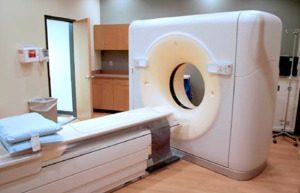Radiation
 Radiation therapy (“radiotherapy”) beams a high dose of radiation directly on tumors damaging the cancerous cells while avoiding the healthy surrounding tissue. Treatment dosage and duration is greater in radiation therapy than the amount used for x-rays and results in sterilizing a tumor and disabling its ability to multiply and grow. This cancer treatment is effectively used in situations when a tumor cannot be reached by surgery or in combination with other treatments.
Radiation therapy (“radiotherapy”) beams a high dose of radiation directly on tumors damaging the cancerous cells while avoiding the healthy surrounding tissue. Treatment dosage and duration is greater in radiation therapy than the amount used for x-rays and results in sterilizing a tumor and disabling its ability to multiply and grow. This cancer treatment is effectively used in situations when a tumor cannot be reached by surgery or in combination with other treatments.
The size of the tumor will determine if radiotherapy is used exclusively or combined with another treatment.
Larger tumors requiring a combination of radiation therapy with surgery or chemotherapy can be used before or during either procedure. Radiotherapy shrinks the tumor to make surgery or chemotherapy more effective, and if radiation therapy is used after chemotherapy or surgery, any remaining cancer cells are destroyed.
While the type of radiotherapy chosen depends upon the type of tumor and characteristics of a patient’s cancer case, it is also a decision reached following conversations between the patient and oncologist. Several of the more commonly used radiation therapies include:

Brachytherapy
Brachytherapy is an internal radiotherapy technique that is a quick and effective treatment for some patients. It delivers low doses of radiation locally from implants placed close to, or inside, the tumor(s) in the body and can be administered in one of two different ways.
Once the tumor is removed, the surgeon inserts special tubes (catheters) into the tumor bed. After five to six days after surgery allowing time for the surgical site to heal, radioactive seeds are inserted into each of the catheters. The seeds remain in place for an average of five days delivering a high dose of radiotherapy to the area and removed when therapy concludes.
 The entire treatment is completed within one to two days, compared to the five to seven weeks required for external beam radiation therapy (EBRT). It can also be used in combination with other treatments.
The entire treatment is completed within one to two days, compared to the five to seven weeks required for external beam radiation therapy (EBRT). It can also be used in combination with other treatments.
In more complex cases, brachytherapy will be followed by a course of external radiation for five weeks.
External-Beam Radiation Therapy (EBRT)
As the name suggests, this is an external treatment with doses of radiation administered outside of the body directly to the region of the tumor and surrounding tissues. Higher, more precise doses of radiation target the tumor minimizing damage to healthy tissue and nearby organs and reducing any risk of side effects. It can be given before or after surgery.
Patients receive EBRT on an outpatient basis over a seven to eight week period five days a week. Treatments take only a few minutes thereby minimally disrupting a patient’s life.
Intensity Modulated Radiation Therapy (IMRT)
This is a state-of-the-art treatment that uses computer technology to deliver a precise dose of radiation. The sophisticated computer-guided technique can accurately assess a tumor’s characteristics to result in the safe delivery of higher doses of radiation. The goal with IMRT is to successfully shrink a tumor for the best possible surgery outcome and reduce risk of recurrence. The technique is especially helping in treating difficult-to-reach tumors.
The accuracy of this therapy can provide tremendous benefit to a patient and particularly advantageous when a patient’s allowable dose of conventional radiation therapy has been exhausted.
Learn more about radiotherapy by visiting WebMD.com.
Contact the Cancer Center Specialists Today
The Cancer Center offers patients the best possible solution for recovery from cancer along with honoring the whole person by emphasizing both physical and emotional care. We work closely with our patients’ radiologists to ensure a comprehensive, appropriate plan is in place. Please contact our center at 310-552-9999 to schedule a consultation with one of our oncologists to discuss your personal situation and answer your questions.
Learn more about cancer surgery.



